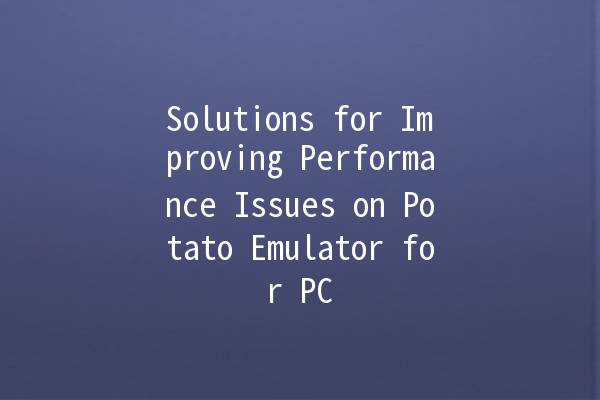The Potato Emulator is a popular choice among gamers who want to enjoy mobile games on their PC. However, many users experience performance issues such as lagging and stuttering that can ruin the gaming experience. In this article, we will explore practical solutions to enhance the performance of the Potato Emulator on your PC. By implementing these tips, you can significantly improve your gaming experience and achieve smoother gameplay.
Understanding Performance Bottlenecks
Before diving into solutions, it's essential to understand what causes performance issues in the Potato Emulator. Various factors can contribute to a laggy experience, including:
Insufficient Hardware: If your PC does not meet the minimum requirements for running Potato Emulator, you may encounter performance issues.
Graphics Settings: The emulator’s graphics settings can greatly affect performance. High settings may work well on powerful machines but can cause slowdowns on less capable systems.

Background Processes: Other applications running in the background can consume CPU and RAM, leading to potential slowdowns while using the emulator.
By identifying these bottlenecks, you can take targeted actions to remedy the situation. Here are five specific techniques to consider:
Explanation
Adjusting your system settings can enhance overall performance. Make sure your operating system is optimized for gaming to allow the Potato Emulator to run smoothly.
Implementation
Disable Visual Effects: Navigate to System Properties, click on the Performance Settings, and select "Adjust for best performance." This will disable unnecessary visual effects that consume resources.
Set Power Plan to High Performance: Under Control Panel > Hardware and Sound > Power Options, choose the "High Performance" plan to ensure your CPU is running at maximum capability.
Update Windows: Keeping your operating system updated with the latest patches can improve stability and performance.
Explanation
Tweaking the settings within the Potato Emulator itself can make a significant difference in performance.
Implementation
Adjust Resolution: Lower the resolution in the emulator settings to reduce the strain on your PC’s resources. A lower resolution requires less graphical processing power, leading to better frame rates.
Set Graphics Renderer: Choose between OpenGL and DirectX in the settings. Some systems perform better with one over the other, so testing both can help determine which is best for your setup.
Enable Virtualization: Ensure that virtualization is enabled in your BIOS settings for smoother performance, as this allows better utilization of your CPU.
Explanation
Running too many applications simultaneously can divert resources away from the Potato Emulator, resulting in slower performance.
Implementation
Task Manager: Open Task Manager (Ctrl + Shift + Esc) to identify resourcehungry applications. Close any unnecessary applications to free up CPU and RAM.
Disable Startup Programs: Prevent unneeded applications from launching at startup. Go to Task Manager > Startup and disable any programs that are not essential.
Explanation
If you find that performance issues persist even after optimizing settings, it may be time to consider upgrading your hardware.
Implementation
Add More RAM: Increasing the amount of RAM in your PC can provide a significant boost, especially if you are currently running close to your system's limits.
Upgrade the GPU: A more powerful graphics card can greatly enhance performance in emulators, allowing for higher settings and smoother gameplay.
Use SSD for Storage: If you’re operating from a traditional hard drive, consider upgrading to an SSD. The speed of SSDs improves loading times and overall responsiveness.
Explanation
Maintaining your system and regularly updating software can prevent performance degradation over time.
Implementation
Clean Your System: Use tools like CCleaner to remove junk files and temporary data that can accumulate and slow down your PC. Regular system cleaning helps maintain optimal performance.
Update Emulator: Keep the Potato Emulator updated with the latest versions, patches, and bug fixes. Developers often release updates that address performance issues and improve compatibility.
Check for Driver Updates: Ensure that your graphics card drivers are up to date. Manufacturers frequently release updates that improve performance in demanding applications.
Frequently Asked Questions (FAQs)
Even if your hardware is powerful, other factors like incorrect settings, background processes, or software conflicts may cause lag. Try optimizing your system and emulator settings as mentioned above.
The minimum requirements usually include at least 4GB of RAM, a dualcore CPU, and a dedicated graphics card with support for OpenGL 2.
While it's possible to run it without virtualization, performance will likely be significantly worse. Enabling virtualization in the BIOS will allow the emulator to utilize your CPU more effectively, enhancing overall performance.
It depends on your system configuration. Some users find that DirectX provides better performance, while others prefer OpenGL. Experimenting with both options in the emulator settings will help you determine which is best for your setup.
You can check for the latest graphics driver updates through the manufacturer’s website (e.g., NVIDIA, AMD, Intel) or by using software such as GeForce Experience or Windows Update.
If you are an avid gamer who uses Potato Emulator frequently and faces persistent performance issues, upgrading hardware components like RAM or GPU can provide a noticeable improvement and allow you to enjoy more demanding games.
By implementing these solutions, you should experience enhanced performance on the Potato Emulator, allowing you to enjoy your favorite mobile games on your PC seamlessly. Remember that ongoing maintenance and timely upgrades will keep your system running smoothly for years to come. Enjoy your gaming!